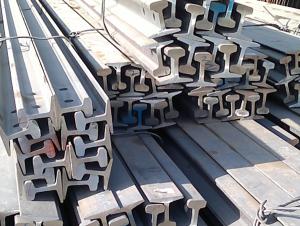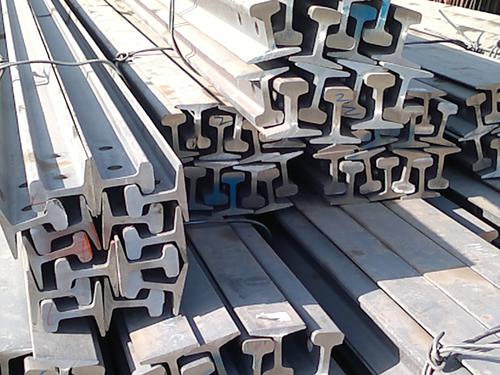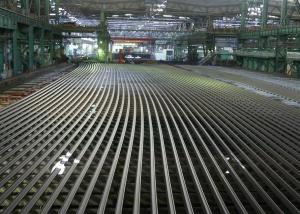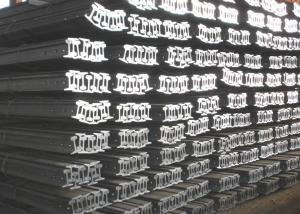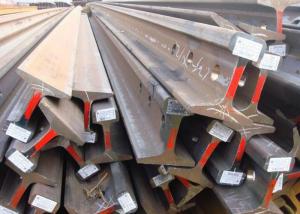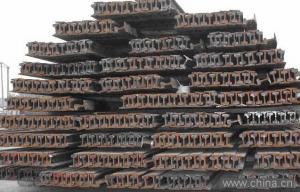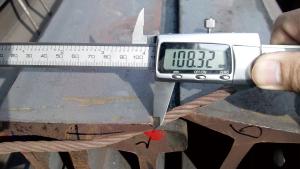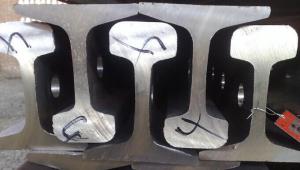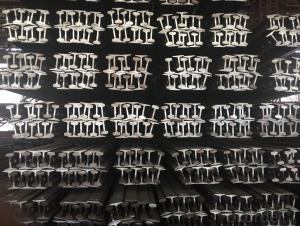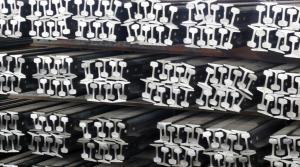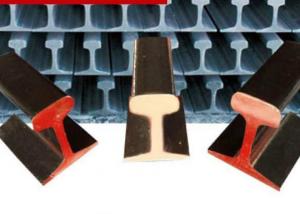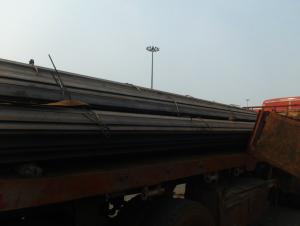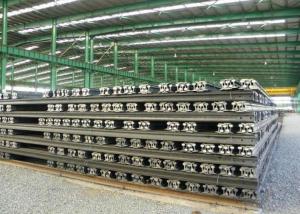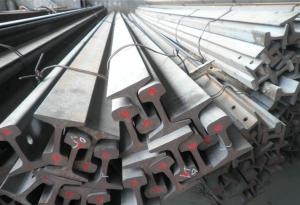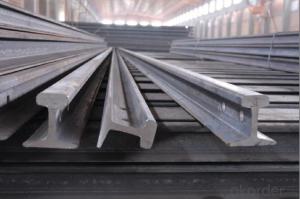Steel Heavy Rail 50MN, U71MN, 900A, 110A
- Loading Port:
- China main port
- Payment Terms:
- TT or LC
- Min Order Qty:
- 25 m.t.
- Supply Capability:
- 100000 m.t./month
OKorder Service Pledge
OKorder Financial Service
You Might Also Like
Product Description of Steel Heavy Rail 50MN, U71MN, 900A, 110A:
Sizes: 38kg, 43kg, 45kg, 50kg, 60kg.
Production Standard: GB2585-81, DIN, AREMA, JIS, BS, UIC, etc.
Material: 50MN, U71MN, 900A, 110A, etc.
Length: 6m-25m according to the requriements of the clients
Usages of Steel Heavy Rail 50MN, U71MN, 900A, 110A:
Light rail is mainly used in forest region, mines, factories and construction sites laid of the place such as temporary transport line and light motorcycles with line. Be widely used for railway, subway, transportation track, express, curve way, tunnel way and so on.
Packaging & Delivery of Steel Heavy Rail 50MN, U71MN, 900A, 110A:
1. Packing: it is nude packed in bundles by steel wire rod
2. Bundle weight: not more than 3.5MT for bulk vessel; less than 3 MT for container load
3. Marks:
Color marking: There will be color marking on both end of the bundle for the cargo delivered by bulk vessel. That makes it easily to distinguish at the destination port.
Tag mark: there will be tag mark tied up on the bundles. The information usually including supplier logo and name, product name, made in China, shipping marks and other information request by the customer.
If loading by container the marking is not needed, but we will prepare it as customer request.
4. Transportation: the goods are delivered by truck from mill to loading port, the maximum quantity can be loaded is around 40MTs by each truck. If the order quantity cannot reach the full truck loaded, the transportation cost per ton will be little higher than full load.
5. Delivered by container or bulk vessel
6. Delivery Time: All the Hot Rolled Steel Rail will be transpoted at the port of Tianjin, China within 30 days after receiving the advance payment by T/T or the orginal L/C at sight.
Inspection of Steel Heavy Rail 50MN, U71MN, 900A, 110A:
We will send the MTC of the factory to the clients dirrectly which contain the anlisis of the heat, chemiqul composition, phisical characteristicas, etc.
And our inspectors will arrive at the factory to meke the inspection of the size, length, weight and quantity before the transportation from the factory.
FAQ:
Q1: Why buy Materials & Equipment from OKorder.com?
A1: All products offered by OKorder.com are carefully selected from China's most reliable manufacturing enterprises. Through its ISO certifications, OKorder.com adheres to the highest standards and a commitment to supply chain safety and customer satisfaction.
Q2: What makes stainless steel stainless?
A2: Stainless steel must contain at least 10.5 % chromium. It is this element that reacts with the oxygen in the air to form a complex chrome-oxide surface layer that is invisible but strong enough to prevent further oxygen from "staining" (rusting) the surface. Higher levels of chromium and the addition of other alloying elements such as nickel and molybdenum enhance this surface layer and improve the corrosion resistance of the stainless material.
Q3: Can stainless steel rust?
A3: Stainless does not "rust" as you think of regular steel rusting with a red oxide on the surface that flakes off. If you see red rust it is probably due to some iron particles that have contaminated the surface of the stainless steel and it is these iron particles that are rusting. Look at the source of the rusting and see if you can remove it from the surface.
Images:
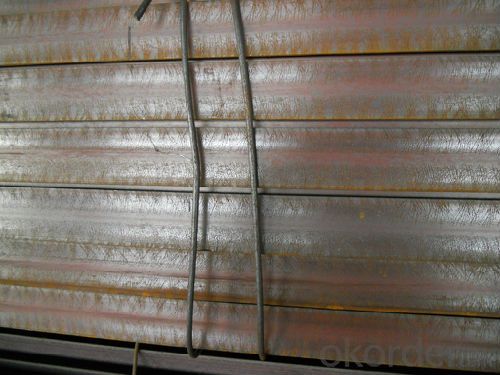
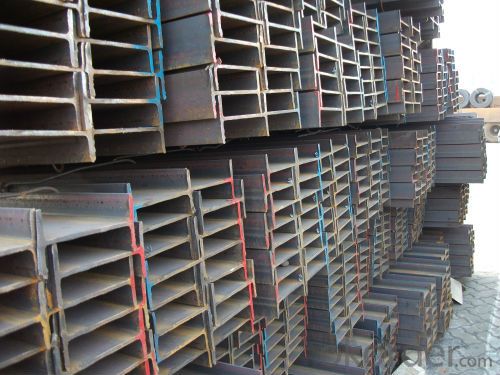
- Q: What are the safety measures taken for workers involved in steel rail maintenance?
- In steel rail maintenance, various safety measures are taken to ensure the well-being and protection of workers. These measures are implemented to minimize the risk of accidents, injuries, and occupational hazards. Some of the safety measures taken for workers involved in steel rail maintenance include: 1. Personal Protective Equipment (PPE): Workers are provided with appropriate PPE such as helmets, safety glasses, high visibility vests, gloves, and steel-toed boots. These gears protect them from potential hazards like falling objects, sparks, and sharp edges. 2. Training and Education: Workers receive thorough training on safety protocols, procedures, and best practices specific to steel rail maintenance. This includes instruction on the proper use of equipment, handling of materials, and understanding of potential hazards. 3. Hazard Identification and Risk Assessment: Regular inspections and risk assessments are conducted to identify potential hazards, such as loose rails, damaged equipment, or hazardous substances. This allows for prompt corrective actions to be taken to minimize risks. 4. Safe Work Practices: Standard operating procedures are established and enforced to ensure workers follow safe work practices. This includes guidelines on proper lifting techniques, equipment usage, and adherence to safety protocols. 5. Equipment Maintenance and Inspection: Regular maintenance and inspections of equipment, tools, and machinery are conducted to ensure they are in proper working condition. This helps prevent malfunctions or accidents caused by faulty equipment. 6. Emergency Preparedness: Workers are trained in emergency evacuation procedures and have access to first aid kits, fire extinguishers, and emergency contact information. Regular drills and safety meetings are conducted to ensure workers are prepared for potential emergencies. 7. Communication and Supervision: Effective communication channels are established between workers and supervisors to ensure any safety concerns or issues are promptly addressed. Supervisors have the responsibility to monitor work activities and enforce safety protocols. 8. Ergonomic Considerations: Steps are taken to ensure that workers are not subjected to excessive physical strain or repetitive movements. Ergonomic principles are applied to minimize the risk of musculoskeletal injuries. 9. Hazardous Substance Management: Proper handling, storage, and disposal procedures are followed for hazardous substances such as chemicals and solvents. Workers are trained on the safe use of these substances and provided with appropriate protective measures. 10. Continuous Improvement: Safety measures are regularly reviewed and updated to incorporate best practices and latest industry standards. Feedback from workers is taken into account to identify areas that require improvement. By implementing these safety measures, employers can create a safe working environment for workers involved in steel rail maintenance, reducing the risk of accidents and ensuring their well-being.
- Q: Are there any environmental benefits of using steel rails?
- Yes, there are several environmental benefits of using steel rails. Firstly, steel is highly durable and has a long lifespan, leading to reduced maintenance needs and less frequent replacement compared to other materials like wood or concrete. This results in lower resource consumption and reduced waste generation. Additionally, steel is highly recyclable, with a recycling rate of over 90%, ensuring that old rails can be repurposed rather than ending up in landfills. Moreover, steel rails offer a smoother and more efficient ride, reducing energy consumption and carbon emissions from transportation. Overall, the use of steel rails contributes to sustainable infrastructure and helps minimize the environmental impact of railways.
- Q: Can steel rails be used in heritage railways?
- Yes, steel rails can be used in heritage railways. In fact, steel rails are commonly used in modern heritage railway systems due to their durability and longevity. They provide a safe and reliable track infrastructure, ensuring the smooth operation of heritage trains while preserving the historical charm of the railway.
- Q: What are the different rail profiles available for steel rails?
- The different rail profiles available for steel rails include flat-bottomed rails, bullhead rails, vignole rails, and grooved rails.
- Q: How are steel rails protected against water damage?
- Steel rails are protected against water damage through a variety of methods, including the application of protective coatings and regular maintenance. Protective coatings such as paint or specialized corrosion-resistant materials are applied to the surface of the rails to create a barrier between the steel and water, preventing direct contact and reducing the risk of rust and corrosion. Regular maintenance, which includes inspections, cleaning, and repairs, helps identify and address any potential water damage issues promptly. Additionally, proper drainage systems are installed to minimize the accumulation of standing water around the rails, further reducing the risk of water damage.
- Q: How are steel rails protected against ground movement?
- Steel rails are typically protected against ground movement through the use of ballast, which serves as a stabilizing layer beneath the tracks. This layer of crushed stones or gravel provides support, prevents excessive movement, and helps distribute the weight of the trains. Additionally, proper drainage systems are installed to prevent water accumulation and subsequent ground instability.
- Q: What is the role of steel rails in reducing train maintenance downtime?
- The role of steel rails in minimizing train maintenance downtime is crucial. These rails offer a surface that is both durable and reliable, allowing trains to run smoothly without excessive wear and tear. This means fewer repairs and less maintenance are needed, as the steel rails withstand heavy loads and provide stability. They also resist extreme weather conditions, extending their lifespan and reducing the need for frequent interventions. Moreover, steel rails are engineered to resist deformation and cracking, even under immense train pressure. This reduces the risk of rail failures, which could cause train derailments and lengthy repair periods. By maintaining the integrity of the rail infrastructure, steel rails contribute to the overall safety and reliability of the train system. Additionally, the use of steel rails enables efficient maintenance practices. Regular inspections and proactive maintenance activities, such as grinding and reprofiling, can be performed on the rails to address minor issues before they become major problems. This approach helps identify potential defects early on, preventing train disruptions and minimizing overall repair time. In conclusion, steel rails are vital in reducing train maintenance downtime by providing a dependable and strong surface for trains to travel on. Their durability, stability, and resistance to deformation and cracking guarantee safe and efficient train operations. With the ability to facilitate proactive maintenance practices, steel rails help prevent major issues and enable timely repairs, ultimately improving train reliability and reducing downtime.
- Q: How are steel rails manufactured to meet specific standards?
- Steel rails are manufactured to meet specific standards through a rigorous process that involves carefully selected raw materials, precise manufacturing techniques, and stringent quality control measures. The production begins with the selection of high-quality steel, which is then heated and rolled to form the desired shape of the rail. The rails are further processed through various stages such as cooling, straightening, and cutting to achieve the required dimensions and mechanical properties. Additionally, strict quality checks are conducted at each step to ensure the rails meet the specific standards for strength, durability, and dimensional accuracy.
- Q: What are the different types of rail switches used with steel rails?
- 1. The commonly used rail switches with steel rails include turnouts, also known as switches or points. These switches consist of movable rails that divert trains from one track to another, typically at junctions or merge/diverge points. 2. Another type of rail switch used with steel rails is the crossover. Crossovers allow trains to move from one track to a parallel track, providing flexibility in train operations. They are often used for bypassing track sections or accessing different platforms. 3. Diamond crossings are rail switches that allow trains to cross each other at junctions without curved tracks. They have a diamond-shaped layout, with two tracks intersecting diagonally. Diamond crossings are commonly found in complex rail networks with multiple line intersections. 4. Slip switches, also known as catch points or derailers, are used to prevent trains from accidentally entering out-of-service or maintenance tracks. They have movable rails that align to divert trains onto a separate track or into a safe area. Slip switches are crucial safety features in rail infrastructure. 5. Gauntlet tracks are used in limited space or urban areas. They consist of overlapping tracks that enable trains to pass in opposite directions on a shared track section. Gauntlet tracks are often employed when constructing separate tracks for each direction is not feasible. These examples showcase the various rail switches used with steel rails. Each type serves a specific purpose, ensuring flexibility and safety in train operations. The selection of rail switches depends on the specific requirements of the rail network and installation location.
- Q: Can steel rails be used in railway systems with sharp curves?
- Yes, steel rails can be used in railway systems with sharp curves. Steel rails are widely used in railways due to their strength, durability, and ability to withstand heavy loads. While sharp curves can pose a challenge for railway systems, steel rails can still be used effectively with certain modifications. In order to accommodate sharp curves, engineers can employ a technique called superelevation, also known as banking or canting. This involves tilting the outer rail of the curve slightly higher than the inner rail, allowing trains to maintain stability and prevent derailment. By adjusting the superelevation, the speed at which trains can safely navigate sharp curves can be increased. Additionally, steel rails can be designed to be more flexible compared to other materials like concrete. This flexibility allows the rails to better adapt to the curvature of the track, reducing stress and increasing the overall safety of the railway system. While steel rails can be used in sharp curves, it is important to note that the design and construction of the railway system must be carefully planned and executed. Factors such as train speed, weight, and the radius of the curve need to be considered to ensure safe operations. Regular maintenance and inspections of the steel rails are also crucial to identify any issues or wear that may arise over time. Overall, steel rails are a suitable choice for railway systems with sharp curves, as long as proper engineering techniques and maintenance practices are implemented to ensure the safety and efficiency of the system.
Send your message to us
Steel Heavy Rail 50MN, U71MN, 900A, 110A
- Loading Port:
- China main port
- Payment Terms:
- TT or LC
- Min Order Qty:
- 25 m.t.
- Supply Capability:
- 100000 m.t./month
OKorder Service Pledge
OKorder Financial Service
Similar products
Hot products
Hot Searches
Related keywords
